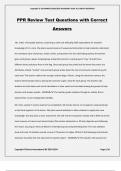Exam (elaborations)
PPR Review Test Questions with Correct Answers
Institution
Practice Tests
PPR Review Test Questions with Correct
Answers
Ms. Vidal, a first grade teacher, is planning a math unit reflecting TEKS expectations for students'
knowledge of U.S. coins. She plans several lessons of sequenced instruction to help students understand
the monetary value of pennies, nickels, dim...
[Show more]
Preview 3 out of 16 pages
Uploaded on
November 11, 2024
Number of pages
16
Written in
2024/2025
Type
Exam (elaborations)
Contains
Questions & answers
Institution
Practice Tests
Course
Practice Tests
$12.49
100% satisfaction guarantee
Immediately available after payment
Both online and in PDF
No strings attached
Copyright © OLIVIAWEST2024/2025 ACADEMIC YEAR. ALL RIGHTS RESERVED




